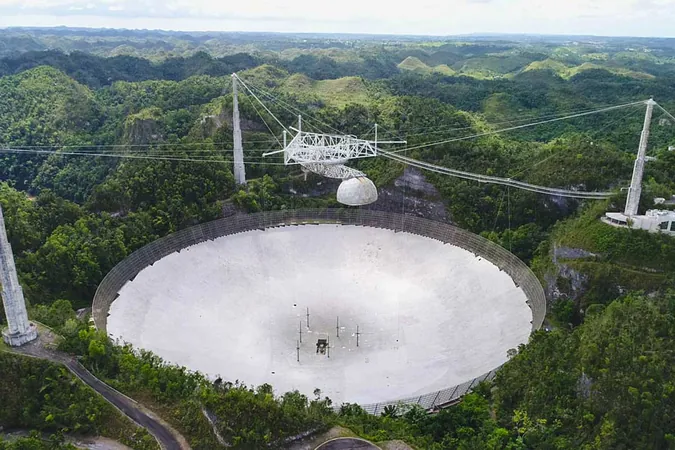
The Arecibo Observatory: A Stellar Legacy and Its Unexpected Downfall
2024-11-06
Author: Emma
Introduction
In 1963, the Arecibo Observatory opened its doors on the picturesque island of Puerto Rico, marking a significant milestone in the field of radio astronomy. With a colossal diameter of 305 meters (approximately 1,000 feet), it held the title of the largest radio telescope in the world for over five decades—only relinquishing that honor in 2016 to China's Five-hundred-meter Aperture Spherical Telescope (FAST). However, the legacy of Arecibo was tragically cut short when its iconic reflector dish collapsed in December 2020 after several support cables failed, prompting the National Science Foundation (NSF) to ultimately decommission the iconic facility.
Investigation into Collapse
Following the collapse, the NSF, in conjunction with the University of Central Florida, launched an in-depth investigation to uncover the factors that led to Arecibo's unfortunate demise. After nearly four years of research, the Committee on Analysis of Causes of Failure and Collapse of the 305-Meter Telescope released an official report. This document outlined that the structural failure was largely the result of weakened infrastructure, exacerbated by long-term zinc creep-induced failure within the telescope’s cable sockets, compounded by earlier damage from Hurricane Maria which swept through the region in 2017.
Historical Significance
Originally named the Arecibo Ionospheric Observatory, the telescope was designed primarily for ionospheric studies part of a ballistic missile defense program. By 1967, the NSF transitioned it to a civilian astronomy research facility. Over the years, Arecibo made revolutionary contributions to science. In 1974, it was the site of the first-ever detection of a binary pulsar, a discovery that earned physicists Russell A. Hulse and Joseph H. Taylor the Nobel Prize in physics nearly two decades later. The observatory also discovered the binary asteroid 4337 Arecibo in 1985, and in 1992, it identified the first exoplanets orbiting the pulsar PSR 1257+12—an extraordinary leap in our understanding of the universe.
The Arecibo Message
Arecibo’s outreach extended beyond mere observation. It sent the historic Arecibo Message in 1974—a pioneering attempt to communicate with potential extraterrestrial civilizations—targeted towards the globular star cluster M13. This pictorial message, crafted by a coalition of scientists from Cornell University and Arecibo, including renowned figures like Frank Drake and Carl Sagan, remains a monumental moment in the annals of human achievement.
The Collapse
The fateful events leading to the 2020 collapse started during Hurricane Maria, which struck the observatory with wind speeds between 105 and 118 mph. Although initial inspections post-hurricane indicated that the telescope’s structural integrity remained intact, repairs were delayed for various reasons, including misprioritized efforts. This ultimately proved catastrophic, as auxiliary and main cables failed in late 2020, leading the NSF to announce plans for a controlled demolition of the telescope.
Tragically, before this could be carried out, another series of cable failures occurred on December 1, 2020, resulting in the instrument platform crashing into the dish below, taking with it fragments of the support towers. Fortunately, this event did not result in any injuries. The investigation revealed that the degradation of the cable spelter sockets had gone unnoticed, leading to an underestimation of the risk posed by the remaining cables.
The Future
As of recent updates from the NSF, while Arecibo's reign as a groundbreaking scientific instrument may have concluded, it will be reborn as the Arecibo C3, an educational center aimed at promoting Science, Computing, and Community (Ciencia, Computación, Comunidad). Although the cherished observatory will no longer serve as a hub for radio astronomy, its spirit will live on through educational initiatives, empowering future generations of scientists, engineers, and innovators and ensuring that Arecibo's remarkable legacy endures in new forms.
Stay tuned for updates as we explore how the Arecibo C3 will inspire a new wave of curiosity and learning in the fields of STEM!









 Brasil (PT)
Brasil (PT)
 Canada (EN)
Canada (EN)
 Chile (ES)
Chile (ES)
 España (ES)
España (ES)
 France (FR)
France (FR)
 Hong Kong (EN)
Hong Kong (EN)
 Italia (IT)
Italia (IT)
 日本 (JA)
日本 (JA)
 Magyarország (HU)
Magyarország (HU)
 Norge (NO)
Norge (NO)
 Polska (PL)
Polska (PL)
 Schweiz (DE)
Schweiz (DE)
 Singapore (EN)
Singapore (EN)
 Sverige (SV)
Sverige (SV)
 Suomi (FI)
Suomi (FI)
 Türkiye (TR)
Türkiye (TR)